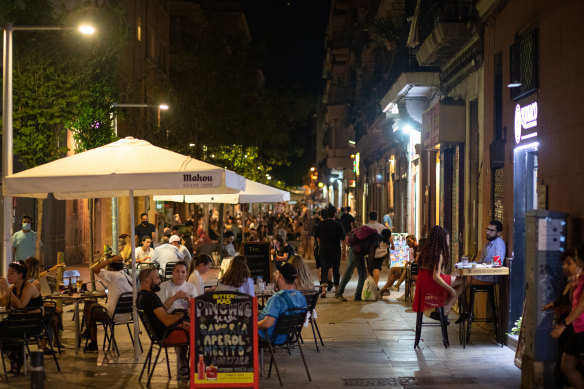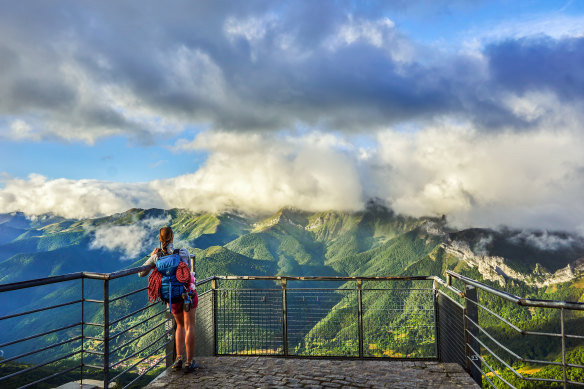Opinion
Ten things we’ll never understand about Spain
Brian Johnston
Travel writerSpain is one of the world’s best destinations, but some social habits and attitudes can be challenging and might leave you scratching your head.

How can lunch last four hours? In Spain, it’s easy.Credit: iStock
Hello and goodbye
If you get stared at in Spain, it’s for one of two reasons. You might be doing something interesting: the Spanish have no problem staring at anything. Or you might have flouted convention by not saying hola when entering a shop, other premises or for that matter, even a lift. It’s also customary to say goodbye (hasta luego will do). Announcing your arrival and departure will serve you well.
The spontaneity
If you’re a forward planner, Spain will rattle you. The Spanish don’t like to be pinned down to what they’ll be doing in an hour, let alone next week. How anything is arranged at all is a mystery. If you agree to meet up with some Spaniards, take the time as a mere indication, and don’t expect anyone to decide what you’re actually going to be doing, or where you’re eating, until the very last moment.
Eating on the hoof

The Spanish love to eat, but they don’t like to walk around while doing it. Credit: iStock
Spain has a very outdoorsy society, and the Spanish love to eat, so why does nobody eat while walking? Only tourists amble along while enjoying an apple or drink. Street food isn’t much of a thing in this land, even though the climate and architectural beauty seem made for it. Perhaps it’s because locals think food should be respected and enjoyed unhurriedly. Follow that philosophy and you’re in for a treat – but you’ll be sitting down.
The long lunch
How is it possible to make lunch last four hours? If ever you’re invited to eat, it would be tempting to bring a novel to read between courses, if that weren’t impolite. Instead, you’re expected to chat the afternoon away, and stay on after all the food is finished to catch up on gossip and discuss politics. What’s wrong with that? Might as well soak up Spanish life instead of studying dead princes in palaces.
Gloomy art

Francisco Goya’s Pretty Teacher! 1797-98.Credit: Museo Nacional del Prado
The Spanish are fun-loving and sociable, delight in fiestas and are friendly to foreigners. They enjoy a sunny climate and great food. So why are Spanish churches so sombre, filled with dying saints and severed heads? Why are leading lights of Spanish art such as Goya and Velasquez so gloomy; the portraiture filled with grumpy, frowning people? As for flamenco, it too is sad and haunting. Puzzling, but we’re happy Spanish art doesn’t reflect reality.
The stereotypes
Talking of flamenco, don’t expect to see it everywhere. Just about everything we associate with Spain, from bullfighting to tapas bars, orange-scented plazas to flamboyant festivals, originated in Andalusia. That’s something visitors don’t get about Spain: it isn’t really a single nation but rather a cobbled-together kingdom of once fiercely independent and very different regions. Bullfighting is banned in some regions such as Catalonia. The Basque language is completely unrelated to Spanish. Galicia has a rich Celtic heritage.

Don’t expect to see flamenco dancers throughout the country.Credit: iStock
Loud conversation
For sheer volume, no nationality beats a group of Spaniards at a breakfast buffet, in a train carriage or on a cafe terrace, where they’d outdo lorikeets. The Spaniards love to argue, interrupt, talk over each other, and screech aloud their enjoyment of the moment. Give into it and you’ll enjoy it too. Another amazing thing: the speed at which Spanish flows, seemingly without conversational punctuation or pause. If a Spaniard isn’t talking, best check they haven’t fainted.
More than culture

Picos de Europa is hiking heaven.Credit: iStock
Most people think of cities and big monuments when they think of Spain. What’s often overlooked are the magnificent landscapes, which range from the Sierra Nevada and Pyrenees mountains, where you can ski in winter, to the rolling, arid countryside of Aragon and the stunning volcanic sub-tropical scenery of the Canary Islands. Spain has terrific national parks too, such as Picos de Europa for hiking and Doñana for bird-filled wetlands.
The complaints about tourists
One of the world’s most-visited countries, Spain gets 85 million tourists annually. Sounds like overkill? No, it’s less than two tourists per head of population, compared with Dubai (nearly five) or Malta (six). Tourism provides 13 per cent of Spain’s GDP, and accounted for 71 per cent of real growth in the Spanish economy in 2023. That’s not to say tourism doesn’t have its issues, especially in cities such as Barcelona. But come on: don’t whinge about the golden goose.
Late nights
Oh, the hunger of the unsuspecting tourist out all day sightseeing, who starts looking for a restorative dinner at six o’clock. Only some tapas bars (and dodgy tourist restaurants) open before 8pm, and many locals don’t dine before 10pm. Good news if you’re jet-lagged, though: plazas and bars will still be humming at 3am. Who knows how the Spanish digest their meals, get enough sleep, and rise the next morning for modern-day office hours.
Sign up for the Traveller newsletter
The latest travel news, tips and inspiration delivered to your inbox. Sign up now.